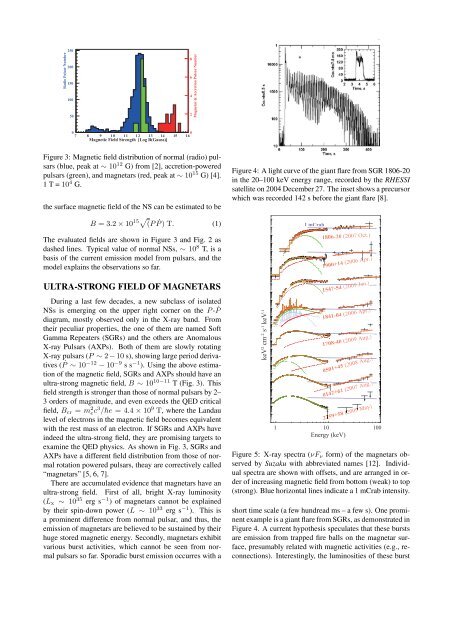Proceedings of International Conference on Physics in ... - KEK
Proceedings of International Conference on Physics in ... - KEK
Proceedings of International Conference on Physics in ... - KEK
Create successful ePaper yourself
Turn your PDF publications into a flip-book with our unique Google optimized e-Paper software.
Radio Pulsar Number<br />
250<br />
200<br />
150<br />
100<br />
50<br />
0<br />
0<br />
7 8 9 10 11 12 13 14 15 16<br />
Magnetic Field Strength [Log B(Gauss)]<br />
Figure 3: Magnetic field distributi<strong>on</strong> <str<strong>on</strong>g>of</str<strong>on</strong>g> normal (radio) pulsars<br />
(blue, peak at ∼ 10 12 G) from [2], accreti<strong>on</strong>-powered<br />
pulsars (green), and magnetars (red, peak at ∼ 10 15 G) [4].<br />
1 T = 10 4 G.<br />
the surface magnetic field <str<strong>on</strong>g>of</str<strong>on</strong>g> the NS can be estimated to be<br />
B = 3.2 × 10 15√ (P ˙<br />
P ) T. (1)<br />
The evaluated fields are shown <strong>in</strong> Figure 3 and Fig. 2 as<br />
dashed l<strong>in</strong>es. Typical value <str<strong>on</strong>g>of</str<strong>on</strong>g> normal NSs, ∼ 10 8 T, is a<br />
basis <str<strong>on</strong>g>of</str<strong>on</strong>g> the current emissi<strong>on</strong> model from pulsars, and the<br />
model expla<strong>in</strong>s the observati<strong>on</strong>s so far.<br />
ULTRA-STRONG FIELD OF MAGNETARS<br />
Dur<strong>in</strong>g a last few decades, a new subclass <str<strong>on</strong>g>of</str<strong>on</strong>g> isolated<br />
NSs is emerg<strong>in</strong>g <strong>on</strong> the upper right corner <strong>on</strong> the P - ˙ P<br />
diagram, mostly observed <strong>on</strong>ly <strong>in</strong> the X-ray band. From<br />
their peculiar properties, the <strong>on</strong>e <str<strong>on</strong>g>of</str<strong>on</strong>g> them are named S<str<strong>on</strong>g>of</str<strong>on</strong>g>t<br />
Gamma Repeaters (SGRs) and the others are Anomalous<br />
X-ray Pulsars (AXPs). Both <str<strong>on</strong>g>of</str<strong>on</strong>g> them are slowly rotat<strong>in</strong>g<br />
X-ray pulsars (P ∼ 2 − 10 s), show<strong>in</strong>g large period derivatives<br />
( ˙ P ∼ 10−12 − 10−9 s s−1 ). Us<strong>in</strong>g the above estimati<strong>on</strong><br />
<str<strong>on</strong>g>of</str<strong>on</strong>g> the magnetic field, SGRs and AXPs should have an<br />
ultra-str<strong>on</strong>g magnetic field, B ∼ 1010−11 T (Fig. 3). This<br />
field strength is str<strong>on</strong>ger than those <str<strong>on</strong>g>of</str<strong>on</strong>g> normal pulsars by 2–<br />
3 orders <str<strong>on</strong>g>of</str<strong>on</strong>g> magnitude, and even exceeds the QED critical<br />
field, Bcr = m2 ec3 /¯he = 4.4 × 109 T, where the Landau<br />
level <str<strong>on</strong>g>of</str<strong>on</strong>g> electr<strong>on</strong>s <strong>in</strong> the magnetic field becomes equivalent<br />
with the rest mass <str<strong>on</strong>g>of</str<strong>on</strong>g> an electr<strong>on</strong>. If SGRs and AXPs have<br />
<strong>in</strong>deed the ultra-str<strong>on</strong>g field, they are promis<strong>in</strong>g targets to<br />
exam<strong>in</strong>e the QED physics. As shown <strong>in</strong> Fig. 3, SGRs and<br />
AXPs have a different field distributi<strong>on</strong> from those <str<strong>on</strong>g>of</str<strong>on</strong>g> normal<br />
rotati<strong>on</strong> powered pulsars, theay are correctively called<br />
“magnetars” [5, 6, 7].<br />
There are accumulated evidence that magnetars have an<br />
ultra-str<strong>on</strong>g field. First <str<strong>on</strong>g>of</str<strong>on</strong>g> all, bright X-ray lum<strong>in</strong>osity<br />
(Lx ∼ 1035 erg s−1 ) <str<strong>on</strong>g>of</str<strong>on</strong>g> magnetars cannot be expla<strong>in</strong>ed<br />
by their sp<strong>in</strong>-down power (L ∼ 1033 erg s−1 ). This is<br />
a prom<strong>in</strong>ent difference from normal pulsar, and thus, the<br />
emissi<strong>on</strong> <str<strong>on</strong>g>of</str<strong>on</strong>g> magnetars are believed to be susta<strong>in</strong>ed by their<br />
huge stored magnetic energy. Sec<strong>on</strong>dly, magnetars exhibit<br />
various burst activities, which cannot be seen from normal<br />
pulsars so far. Sporadic burst emissi<strong>on</strong> occurres with a<br />
8<br />
6<br />
4<br />
2<br />
Magnetar & Accreti<strong>on</strong> Pulsar Number<br />
Figure 4: A light curve <str<strong>on</strong>g>of</str<strong>on</strong>g> the giant flare from SGR 1806-20<br />
<strong>in</strong> the 20–100 keV energy range, recorded by the RHESSI<br />
satellite <strong>on</strong> 2004 December 27. The <strong>in</strong>set shows a precursor<br />
which was recorded 142 s before the giant flare [8].<br />
keV 2 cm -2 s -1 keV -1<br />
1 mCrab<br />
1806-20 (2007 Oct.)<br />
1900+14 (2006 Apr.)<br />
1547-54 (2009 (2009 Jan.) Jan.)<br />
1841-04 (2006 (2006 Apr.) Apr.)<br />
1708-40 (2009 (2009 Aug.) Aug.)<br />
0501+45 (2008 (2008 Aug.) Aug.)<br />
0142+61 (2007 (2007 Aug.) Aug.)<br />
2259+58 2259+58 (2009 (2009 (2009 (2009 (2009 May) May) May) May) May)<br />
1 10 100<br />
Energy (keV)<br />
Figure 5: X-ray spectra (νFν form) <str<strong>on</strong>g>of</str<strong>on</strong>g> the magnetars observed<br />
by Suzaku with abbreviated names [12]. Individual<br />
spectra are shown with <str<strong>on</strong>g>of</str<strong>on</strong>g>fsets, and are arranged <strong>in</strong> order<br />
<str<strong>on</strong>g>of</str<strong>on</strong>g> <strong>in</strong>creas<strong>in</strong>g magnetic field from bottom (weak) to top<br />
(str<strong>on</strong>g). Blue horiz<strong>on</strong>tal l<strong>in</strong>es <strong>in</strong>dicate a 1 mCrab <strong>in</strong>tensity.<br />
short time scale (a few hundread ms – a few s). One prom<strong>in</strong>ent<br />
example is a giant flare from SGRs, as dem<strong>on</strong>strated <strong>in</strong><br />
Figure 4. A current hypothesis speculates that these bursts<br />
are emissi<strong>on</strong> from trapped fire balls <strong>on</strong> the magnetar surface,<br />
presumably related with magnetic activities (e.g., rec<strong>on</strong>necti<strong>on</strong>s).<br />
Interest<strong>in</strong>gly, the lum<strong>in</strong>osities <str<strong>on</strong>g>of</str<strong>on</strong>g> these burst













